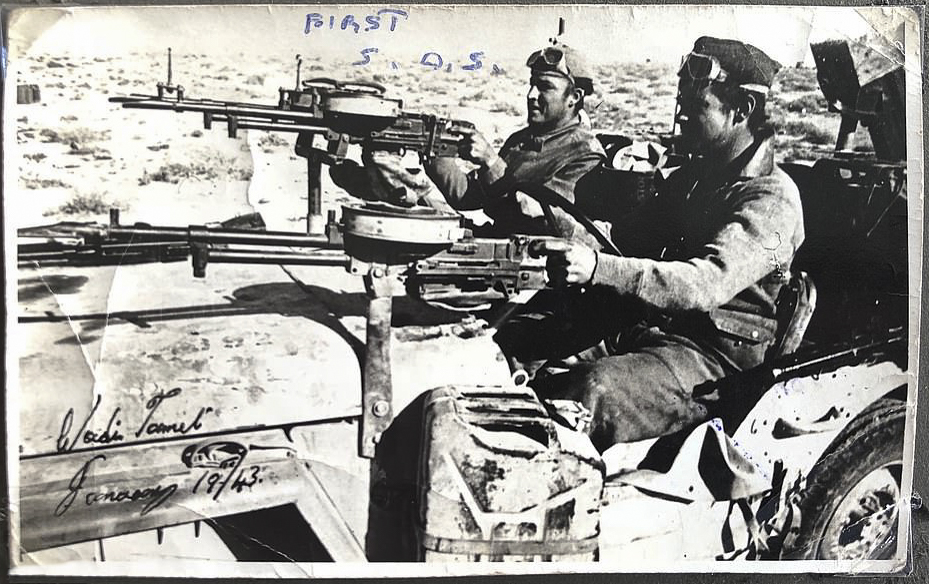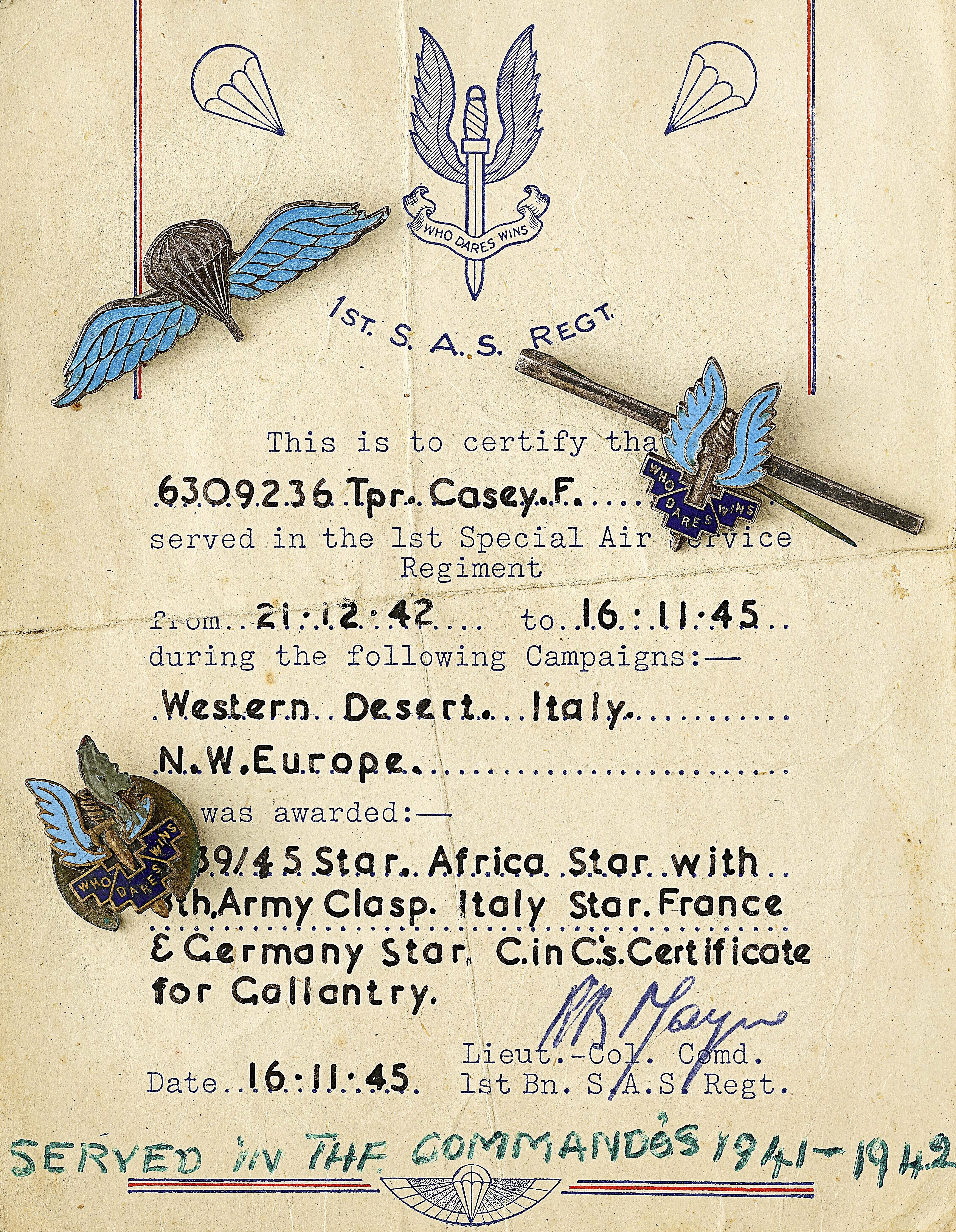‘L’ Detachment SAS ‘original’ Fred Casey’s Memorabilia and Archive

In March 2020, another extraordinary group of documents and memorabilia belonging to one of the first members of the Special Air Service was sold at auction. The SAS archive of Private / Trooper Fred “Killer” Casey comprised eleven lots and included the veteran’s medals, SAS beret, insignia, pocket diary, certificates, Fairbairn-Sykes dagger, map and a personal photo album featuring photographs that had never been publicly displayed before. In total it achieved a hammer price of £21,000 (not including auctioneers commission and fees).
6399236 Trooper Frederick Casey was a pre-war Territorial who had joined the 4th Battalion Royal Sussex Regiment in October 1936. He completed the unit’s annual camps and was the battalion’s boxing champion for three years. At the outbreak of war in 1939 he was mobilised for full-time duty and first saw action in France with the British Expeditionary Force before being evacuated on the 30th of May 1940 as part of the retreat from Dunkirk. Back in England, he volunteered for commando training and on the 10th of July 1940 was posted to F Troop, 3 Commando. On 24 October 1940, 3 Commando and 8 (Guards) Commando were reorganised into the 4th Special Service Battalion and in February 1941 Casey was transferred to 8 (Guards) Commando before being shipped to Egypt as part of Layforce, a composite group consisting of several commando units.
Layforce was initially tasked with conducting operations to disrupt the allied lines of communication in the Mediterranean and it was planned that they would take part in operations to capture the Greek island of Rhodes. However, as the strategic situation in the Middle East turned against the Allies, the commandos found themselves being used as reinforcements throughout the Mediterranean theater. By mid 1941, the authorities in Middle East Command, who had never been able to come to terms with the use of Special Service Troops, took the decision to finally disband Layforce and so on the 6th August 1941 the men made their final journey to Abbassia Barracks in Cairo where they were to be broken up and sent to other units. It was here that Casey saw a request for volunteers for further “Special Duties”.
He applied to join the fledgling Special Air Service (S.A.S.) and in August 1941, after a brief interview with David Stirling also formerly of 8 Commando and now Commanding Officer of the new unit, Fred found himself posted to “L” Detachment, Special Air Service Brigade based at Kabrit. Soon, Fred Casey was on operations, initially working closely with the Long Range Desert Group roaming the desert, raiding the German rear areas, targeting airfields and port installations in their gunned-up, customised, Willys Jeeps. In October 1942, the unit was renamed 1st Special Air Service (1 SAS).









In March 1943 Casey along with other members of A Squadron 1 SAS became part of the Special Raiding Squadron, under the command of Blair ‘Paddy’ Mayne who had taken command of the unit following Stirling’s capture in January. Casey was allotted to 2 Troop, but then, in April he was admitted to hospital and discharged from the squadron, missing out on the spearhead role that the SRS was to play in Operation HUSKY, the Allied invasion of Sicily.
At the end of 1943, the Special Raiding Squadron reverted to the title of 1 SAS and along with 2 SAS was placed under the command of the 1st Airborne Division. On 7 January 1944, Casey returned to operations with 1 SAS after a period of leave. It was around this time in early 1944 that the idea of a SAS Brigade was approved, which resulted in 1 SAS being withdrawn from the Italian theater and returning to Britain.
By March 1944 all components of the SAS Brigade, numbering around 2000 men were assembled in Ayrshire where they were ordered to discard their sandy berets in favour of the airborne maroon beret, although many members opted to defy regulations and retained their sandy beige berets.



They were also issued with battledress shoulder titles for 1, 2, 3 and 4 SAS in the airborne colours of pale blue on maroon. Fred Casey’s 1 SAS title is one of the lots that was sold at the auction achieving a hammer price of £660.
During this period in the UK Fred Casey married his sweetheart, Buddy, and prepared for operations in France as part of Operation OVERLORD, the invasion of Normandy in June 1944. The role of the SAS Brigade in this operation was to prevent German reinforcements reaching the front line and initially only half of the force would be committed, the remainder being held in reserve, including Casey who finally deployed to France in August 1944.

.
At this stage, the SAS groups were carrying out a number of operations behind the lines, disrupting German supplies and communications, tying down large numbers of German troops in the process. Liaising with local resistance groups, operating bases were set up in remote wooded areas and the SAS parties roamed the countryside achieving some success, but also suffering severely at the hands of German security services. Dozens of captured SAS men were murdered in accordance with Hitler’s notorious ‘Commando’ order.
For his part, Fred Casey was presented with the “Commander-in Chief’s Certificate for Gallantry” by Field Marshall Bernard Montgomery in January 1945. When Germany finally surrendered in May 1945 Casey was sent along with 1 and 2 SAS to supervise the disarming of the 200 000 German troops stationed in Norway. This would be his last mission.





.
At the end of the war, the Special Air Service was disbanded. Fred Casey was discharged and transferred to the reserve on 20th of March 1946. After the war he settled in Brighton, East Sussex, became a parquet floor layer and with his wife, Buddy, had two sons, Michael and Charles.
Frederick Casey passed away in 1997 aged 81. His wartime archive and memorabilia which included all the pieces shown here was broken up and sold at auction by militaria auctioneers Bosleys in March 2020.

.
Related Post – A WWII L Detachment S.A.S. Military Cross group awarded for Operation BIGAMY, the 1942 raid on Benghazi
____________________________________________________







